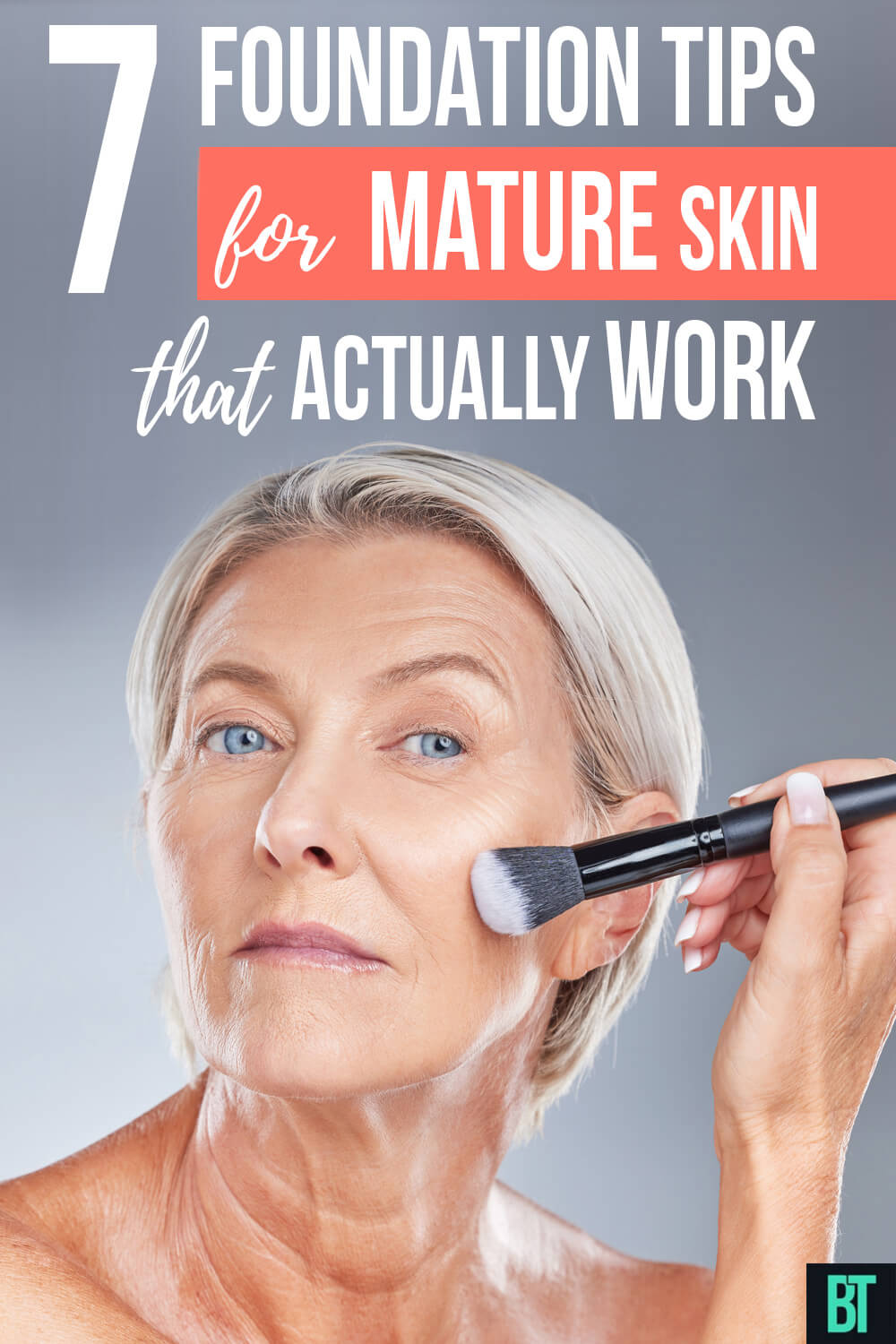How to Apply Foundation for Mature Skin: 7 Easy Tips for a Flawless, Youthful Finish

Have you ever applied your foundation, only to watch it settle into every fine line and emphasize textures you’d rather hide? You’re absolutely not alone. The truth is, mature skin requires a completely different approach to foundation application than the techniques we learned in our twenties and thirties.
As our skin evolves, so must our makeup techniques. The good news? With the right foundation tips for mature skin, you can achieve that coveted youthful finish that enhances your natural beauty rather than masking it.

Why Foundation Application Changes as We Age
Understanding your skin’s transformation is crucial for mastering foundation application. As we age, our skin naturally produces less oil and collagen, leading to drier textures and more pronounced fine lines. Traditional foundation techniques—like vigorous blending or heavy coverage—can actually work against mature skin, settling into creases and creating an unnatural appearance.
Think of it this way: mature skin is like delicate silk fabric. Would you scrub silk with rough motions? Never. The same gentle approach applies to foundation for mature skin.
Our skin’s changing needs require innovative techniques that celebrate texture rather than fight it. The goal isn’t to create a mask—it’s to enhance your skin’s natural radiance while providing the coverage you desire.
7 Expert Tips for Applying Foundation on Mature Skin
1. Start with Hydrating Primer
Primer is your foundation’s best friend—literally. Before even thinking about foundation, apply a hydrating primer with hyaluronic acid or glycerin. This creates a smooth canvas and prevents foundation from settling into fine lines.
Wait three to five minutes after applying primer. Patience pays off here, as rushing this step can lead to pilling and uneven coverage.
Pro tip: Focus primer application on areas where foundation typically settles—around the nose, under the eyes, and on the forehead. These zones benefit most from that extra smoothing boost. For enhanced skin preparation, consider incorporating natural DIY face masks to boost collagen into your weekly routine to create an even smoother foundation base.
2. Choose Lightweight, Hydrating Formulas
Heavy, full-coverage foundations can emphasize texture on mature skin. Instead, embrace lightweight foundation formulas that provide buildable coverage. Look for foundations labeled as “hydrating,” “luminous,” or “dewy finish.”
Serum foundations work exceptionally well for mature skin because they contain skincare ingredients alongside color correction. These formulas blend seamlessly and provide a natural, skin-like finish.
Avoid matte foundations unless you have particularly oily skin. Matte formulas can appear flat and aging on mature skin, while dewy finishes create dimension and youthfulness.
3. Use the Tapping Technique (Not Dragging)
Here’s where technique makes all the difference. Rather than spreading foundation across your face, use gentle tapping motions with your fingertips or beauty sponge.
Start with small amounts of product—you can always build coverage gradually. Apply foundation in light, dabbing motions, working from the center of your face outward. This prevents pulling and stretching delicate skin.
Why tapping works: This technique allows foundation to settle naturally into skin without disturbing the primer underneath or pulling at fine lines.
4. Build Coverage Gradually
The key to natural-looking foundation on mature skin lies in layering thin applications rather than applying one thick coat. Start with a sheer layer, assess coverage, then add more only where needed.
Most people need extra coverage around the nose, chin, and any areas of discoloration. Apply your second layer only to these specific zones rather than covering the entire face again.
Remember: you can always add more, but removing excess foundation disrupts your carefully applied base layers. Speaking of foundation application, avoiding common pitfalls is crucial—learn about foundation mistakes that ruin your glow to ensure flawless results every time.
5. Focus on the T-Zone First
Your T-zone (forehead, nose, and chin) typically requires the most coverage and benefits from foundation application first. These areas also tend to have larger pores that can use extra attention.
After addressing the T-zone, blend outward toward the perimeter of your face. This ensures your most prominent features receive adequate coverage while maintaining a natural transition to your hairline and jawline.
The T-zone approach prevents over-application on the delicate eye and cheek areas, which often need less coverage.
6. Blend with Damp Beauty Sponge
A damp beauty sponge is invaluable for mature skin foundation application. The moisture prevents the sponge from absorbing too much product while creating seamless blending.
Use a stippling motion rather than dragging the sponge across your skin. Press and lift, press and lift—this technique ensures even distribution without disturbing the foundation you’ve carefully placed.
Clean your beauty sponge regularly. A dirty sponge can introduce bacteria to your skin and create uneven application.
7. Set Lightly with Translucent Powder
Less is more when setting foundation for mature skin. Use a light dusting of translucent powder only in areas that tend to get oily or where you need extra longevity.
Focus powder application on the T-zone and under-eye area if you’ve used concealer there. Avoid heavily powdering the entire face, as this can create a dry, aged appearance.
Consider using a setting spray instead of powder for a more natural finish. Setting sprays lock in your foundation while maintaining that coveted dewy glow. For an effective DIY option, try creating your own aloe vera setting spray for makeup hold using natural ingredients that won’t dry out mature skin.
Best Foundation Types for Mature Skin
Not all foundations are created equal when it comes to mature skin compatibility. Hydrating foundation formulas with skincare benefits perform exceptionally well.
Serum Foundations
These lightweight formulas combine makeup with skincare ingredients like hyaluronic acid and vitamins. They provide natural coverage while nourishing your skin throughout wear.
Tinted Moisturizers
Perfect for everyday wear, tinted moisturizers offer light coverage with maximum hydration. They work beautifully for achieving that natural, “your skin but better” look.
Dewy Finish Foundations
Formulations designed to provide luminous finishes help mature skin appear plump and youthful. The subtle glow mimics healthy skin’s natural radiance.
BB and CC Creams
These multi-purpose products combine coverage, skincare, and sometimes SPF protection. They’re excellent for streamlined routines while providing gentle coverage.
Common Foundation Mistakes to Avoid
Even with the best intentions, certain application mistakes can sabotage your mature skin makeup routine. Here’s what to avoid:
Using Too Much Product: Start with less than you think you need. Mature skin shows excess product more readily than younger skin.
Skipping Skin Preparation: Foundation application begins with skincare. Well-moisturized skin provides the ideal foundation base.
Choosing the Wrong Undertone: Foundation that doesn’t match your undertone will look obvious and unnatural. Test foundation on your jawline in natural light.
Applying Foundation to Dry Skin: Always ensure your moisturizer has fully absorbed before foundation application. Dry patches will grab foundation unevenly.
Over-Blending: Excessive blending can actually remove foundation rather than improve it. Work in sections and know when to stop.
At the end of your makeup routine, proper removal is equally important for maintaining healthy skin. Consider using gentle DIY makeup remover for aging skin to cleanse without stripping your skin’s natural moisture barrier.
The journey to mastering foundation application for mature skin requires patience and practice. Remember, the goal isn’t perfection—it’s enhancement. Your skin tells the story of your life experiences, and foundation should celebrate that story while giving you confidence.
Have you tried any of these techniques? What foundation challenges do you face with mature skin? The key lies in embracing your skin’s unique needs and adjusting your routine accordingly.
With these seven expert tips, you’re equipped to achieve that flawless, youthful finish you’ve been seeking. Your foundation routine should feel empowering, not frustrating. Take time to experiment with these techniques and find what works best for your unique skin.
Beautiful skin at any age is possible—it just requires the right approach. And don’t forget to complete your look with age-appropriate color choices—explore lipstick tips for women over 50 to perfectly complement your flawless foundation finish.
https://www.beauty-tips.net/how-to-apply-foundation-for-mature-skin/





